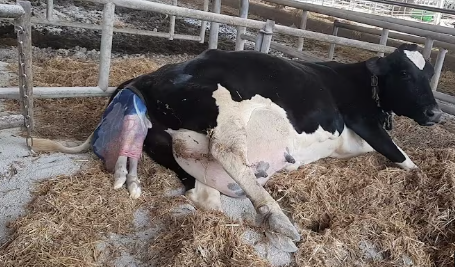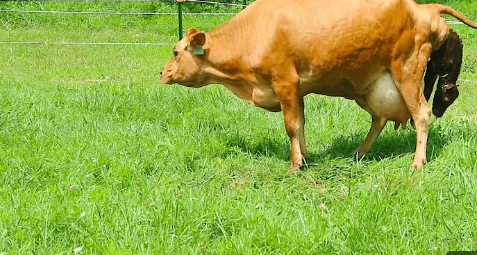Witnessing the Miracle of Life in the Barn
One of the most profound experiences on a farm is watching a cow give birth to her calf. This natural process, known as calving, is not only vital to the continuation of a herd but also a reminder of the beauty and strength in animal life. In this story, we take you through the entire birthing process, from early signs to the calf’s first breath—accompanied by a real-life image showing the final moments before delivery.
Understanding the Calving Process
Cows are pregnant for approximately nine months, much like humans. Throughout this period, farmers carefully monitor the cow’s health, diet, and behavior to ensure both mother and baby are developing well.

As the expected calving date approaches, the cow will start to display signs that labor is near. Her udder will swell, she may become restless, and the ligaments near her tail head will loosen. These signs help farmers prepare for what comes next.
Stage One: Early Labor
In the first stage of labor, the cow becomes increasingly uncomfortable. She may lie down and stand up repeatedly, pace around her pen, or appear more vocal. Internally, her cervix is softening and dilating. This stage can last between 6 to 12 hours and is largely silent from the outside.
As contractions begin, a clear mucus discharge often appears—this is a signal that the birthing process is beginning in earnest.
Stage Two: Delivery of the Calf
This is the most visible and dramatic stage of the birth. Strong uterine contractions begin to push the calf through the birth canal. The cow will likely lie down on her side, as seen in the image above, and begin active labor.

A healthy birth starts with the calf presenting in the “diving position“—front hooves first, followed by the nose. In the photo, you can see the calf’s front legs encased in the amniotic sac as they begin to emerge. This is a good sign, indicating the calf is in the correct position for a natural delivery.
With each contraction, more of the calf is pushed out. Sometimes the calf is born in one strong push, while other times it takes several. In normal conditions, this stage lasts 30 minutes to 2 hours.
If the labor continues without progress beyond this time, a farmer or veterinarian may intervene to assist, especially if the calf is too large or positioned incorrectly.
Stage Three: Expelling the Placenta
After the calf is born, the cow enters the third stage of calving: passing the placenta. This usually occurs within 6 hours of birth. While this stage may seem less exciting, it is critical for the cow’s health. Retained placentas can lead to serious infections and complications.
During this time, the farmer checks to ensure the cow is comfortable, not in distress, and drinking water. A stress-free environment allows her to recover properly and care for her new calf.
After Birth: A New Life Begins
Within minutes of being born, the calf begins to move. The mother licks it clean, stimulating its breathing and circulation. This immediate bonding process is essential for the health and emotional connection between cow and calf.
The calf will try to stand within 30 minutes, although it may take a few attempts. Nursing usually follows shortly after. The first milk, known as colostrum, is rich in antibodies that help protect the newborn from illness.
Farmers closely monitor this first feeding to make sure the calf latches properly and gets enough nutrition. If the calf is weak or unable to nurse, supplemental colostrum may be given.
When Help Is Needed
While most cows give birth naturally, there are times when complications arise. Difficult births (called dystocia) can occur due to calf size, incorrect position, or health issues with the mother. In these cases, a trained farmer or veterinarian will step in, sometimes needing to assist manually or use gentle traction tools to help deliver the calf safely.
Timely assistance can be life-saving for both mother and calf. That’s why experienced farmers are always nearby during calving season, ready to support when needed.
Conclusion: Nature’s Wonder on the Farm
The birth of a calf is one of the most powerful events in farming. It showcases the resilience of life and the role of human care in helping animals thrive. From early labor to the first breath of a wet, wobbly calf, every step in this process reminds us how closely connected we are to nature.
The image of a cow lying down, mid-birth, might be intense—but it’s also a moment of strength, beauty, and hope. Whether you’re raising cattle, visiting a farm, or simply learning from afar, witnessing this process fosters a new appreciation for the animals we depend on and the farmers who care for them.